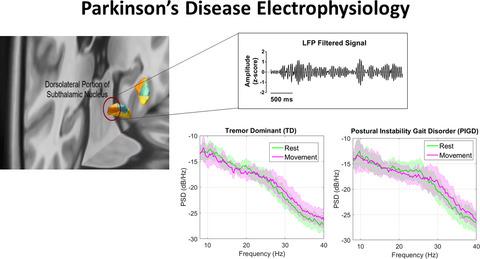当前位置:
X-MOL 学术
›
Eur. J. Neurosci.
›
论文详情
Our official English website, www.x-mol.net, welcomes your
feedback! (Note: you will need to create a separate account there.)
Spectral characteristics of subthalamic nucleus local field potentials in Parkinson's disease: Phenotype and movement matter
European Journal of Neuroscience ( IF 2.7 ) Pub Date : 2021-01-04 , DOI: 10.1111/ejn.15103 Fabio Godinho 1, 2, 3 , Arnaldo Fim Neto 1, 4, 5 , Bruno Leonardo Bianqueti 1, 4 , Julia Baldi de Luccas 1, 4 , Eduardo Varjão 2 , Paulo Roberto Terzian Filho 2 , Eberval Gadelha Figueiredo 6 , Tiago Paggi Almeida 1, 7, 8 , Takashi Yoneyama 7 , André Kazuo Takahata 1, 4 , Maria Sheila Rocha 9 , Diogo Coutinho Soriano 1, 4
European Journal of Neuroscience ( IF 2.7 ) Pub Date : 2021-01-04 , DOI: 10.1111/ejn.15103 Fabio Godinho 1, 2, 3 , Arnaldo Fim Neto 1, 4, 5 , Bruno Leonardo Bianqueti 1, 4 , Julia Baldi de Luccas 1, 4 , Eduardo Varjão 2 , Paulo Roberto Terzian Filho 2 , Eberval Gadelha Figueiredo 6 , Tiago Paggi Almeida 1, 7, 8 , Takashi Yoneyama 7 , André Kazuo Takahata 1, 4 , Maria Sheila Rocha 9 , Diogo Coutinho Soriano 1, 4
Affiliation

|
Parkinson's disease (PD) is clinically heterogeneous across patients and may be classified in three motor phenotypes: tremor dominant (TD), postural instability and gait disorder (PIGD), and undetermined. Despite the significant clinical characterization of motor phenotypes, little is known about how electrophysiological data, particularly subthalamic nucleus local field potentials (STN‐LFP), differ between TD and PIGD patients. This is relevant since increased STN‐LFP bandpower at α–β range (8–35 Hz) is considered a potential PD biomarker and, therefore, a critical setpoint to drive adaptive deep brain stimulation. Acknowledging STN‐LFP differences between phenotypes, mainly in rest and movement states, would better fit DBS to clinical and motor demands. We studied this issue through spectral analyses on 35 STN‐LFP in TD and PIGD patients during rest and movement. We demonstrated that higher β2 activity (22–35 Hz) was observed in PIGD only during rest. Additionally, bandpower differences between rest and movement occurred at the α–β range, but with different patterns as per phenotypes: movement‐induced desynchronization concerned lower frequencies in TD (10–20 Hz) and higher frequencies in PIGD patients (21–28 Hz). Finally, when supervised learning algorithms were employed aiming to discriminate PD phenotypes based on STN‐LFP bandpower features, movement information had improved the classification accuracy, achieving peak performances when TD and PIGD movement‐induced desynchronization ranges were considered. These results suggest that STN‐LFP β‐band encodes phenotype‐movement dependent information in PD patients.
中文翻译:

帕金森病丘脑底核局部场电位的光谱特征:表型和运动物质
帕金森氏病 (PD) 在不同患者的临床上具有异质性,可分为三种运动表型:震颤显性 (TD)、姿势不稳和步态障碍 (PIGD) 和未确定。尽管运动表型具有显着的临床特征,但对于 TD 和 PIGD 患者之间的电生理数据,特别是丘脑下核局部场电位 (STN-LFP) 的差异知之甚少。这是相关的,因为在 α-β 范围(8-35 Hz)增加的 STN-LFP 带宽被认为是潜在的 PD 生物标志物,因此是驱动适应性深部脑刺激的关键设定点。承认表型之间的 STN-LFP 差异,主要是在休息和运动状态,将更好地使 DBS 适应临床和运动需求。我们通过对 TD 和 PIGD 患者在休息和运动期间的 35 STN-LFP 进行光谱分析来研究这个问题。我们证明了较高的 β仅在休息期间在 PIGD 中观察到2活动(22-35 Hz)。此外,休息和运动之间的带宽差异发生在 α-β 范围内,但根据表型具有不同的模式:运动引起的不同步涉及 TD 的较低频率 (10-20 Hz) 和 PIGD 患者的较高频率 (21-28 Hz) )。最后,当采用监督学习算法基于 STN-LFP 带宽特征区分 PD 表型时,运动信息提高了分类精度,在考虑 TD 和 PIGD 运动引起的不同步范围时实现了最佳性能。这些结果表明 STN-LFP β 带编码 PD 患者的表型运动相关信息。
更新日期:2021-01-04
中文翻译:

帕金森病丘脑底核局部场电位的光谱特征:表型和运动物质
帕金森氏病 (PD) 在不同患者的临床上具有异质性,可分为三种运动表型:震颤显性 (TD)、姿势不稳和步态障碍 (PIGD) 和未确定。尽管运动表型具有显着的临床特征,但对于 TD 和 PIGD 患者之间的电生理数据,特别是丘脑下核局部场电位 (STN-LFP) 的差异知之甚少。这是相关的,因为在 α-β 范围(8-35 Hz)增加的 STN-LFP 带宽被认为是潜在的 PD 生物标志物,因此是驱动适应性深部脑刺激的关键设定点。承认表型之间的 STN-LFP 差异,主要是在休息和运动状态,将更好地使 DBS 适应临床和运动需求。我们通过对 TD 和 PIGD 患者在休息和运动期间的 35 STN-LFP 进行光谱分析来研究这个问题。我们证明了较高的 β仅在休息期间在 PIGD 中观察到2活动(22-35 Hz)。此外,休息和运动之间的带宽差异发生在 α-β 范围内,但根据表型具有不同的模式:运动引起的不同步涉及 TD 的较低频率 (10-20 Hz) 和 PIGD 患者的较高频率 (21-28 Hz) )。最后,当采用监督学习算法基于 STN-LFP 带宽特征区分 PD 表型时,运动信息提高了分类精度,在考虑 TD 和 PIGD 运动引起的不同步范围时实现了最佳性能。这些结果表明 STN-LFP β 带编码 PD 患者的表型运动相关信息。











































 京公网安备 11010802027423号
京公网安备 11010802027423号